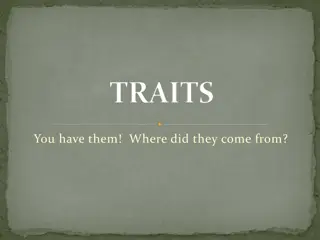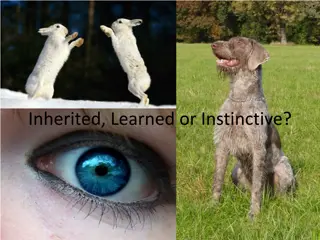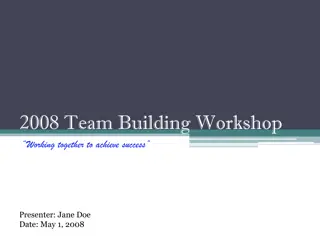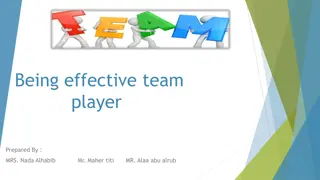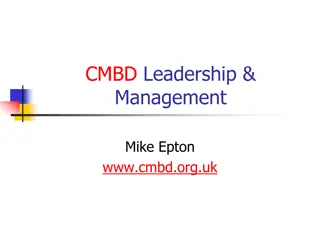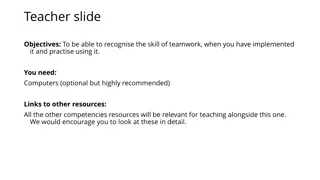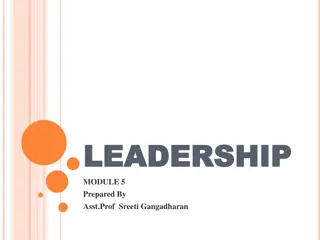All About Team Building, Teamwork, and Leadership Traits
Explore the importance of team building, teamwork, and essential leadership traits. Learn about the purpose of a team, the need for teams in companies, forming effective teams, and the character traits that contribute to team success. Discover roles and responsibilities within a team to enhance cooperation and productivity.
Download Presentation

Please find below an Image/Link to download the presentation.
The content on the website is provided AS IS for your information and personal use only. It may not be sold, licensed, or shared on other websites without obtaining consent from the author. Download presentation by click this link. If you encounter any issues during the download, it is possible that the publisher has removed the file from their server.
E N D
Presentation Transcript
TEAM BUILDING AND TEAM BUILDING AND TEAMWORK TEAMWORK Rachel Clayberg Nichole Lynch
What is a Team? What is a Team? Any group of people organized to work together or interdependently in order to cooperatively meet the needs of their customers by accomplishing a purpose or goal. Together Everyone Accomplishes More
Need for a Team Need for a Team Why do companies use teams? Satisfies the human social need to belong Two heads are better than one The whole can be greater than the sum of its parts Team members build trust and want to help each other Promotes better communication Multiplies the potential of individual members Produces positive peer pressure
Purpose of a Team Purpose of a Team Provides a framework that will increase the ability of employees to participate in planning, problem solving, and decision making.
Forming a Team Forming a Team Makeup Should be composed of people who are most likely going to be able to satisfy the team s mission effectively. Commitment to the team and its purpose. Diversity of skills and personalities.
Character Traits & Teamwork Character Traits & Teamwork What are some traits that can contribute to the success of a team? Honesty/integrity Selflessness Dependability Enthusiasm Responsibility Cooperativeness Initiative Patience Resourcefulness Punctuality Tolerance/sensitivity Perseverance
Forming a Team Forming a Team Roles and Responsibilities Team Leader Team Recorder Team Quality Advisor Team Member
Forming a Team Forming a Team Team Leader Official contact between the team and the rest of the organization Official record keeper Serve as a team member Implement team recommendation Will be the coach for the rest of the team
Forming a Team Forming a Team Coaching Team leaders should facilitate team development and continuous improvement Give teams a clearly defined charter Make team development and team building constant activities Mentor team members Promote mutual respect between themselves and team members Positively promote diversity within the team Employee empowerment
Forming a Team Forming a Team Team Recorder Takes minutes during team meetings Assists the team leader with other types of correspondence that is generated by the team
Forming a Team Forming a Team Team Quality Advisor Focuses on team processes and how decisions are made Assists the team leader in breaking down tasks into component parts and assigning those parts to other team members Helps the team leader prepare for meetings Helps the team members learn to use the scientific approach Helps team members convert their recommendations into presentations that can be made to upper management
Forming a Team Forming a Team Team Charter Team Mission Ground Rules Team Goals
Forming a Team Forming a Team Mission Statement Broad, encompasses all activities, progress can be measured and SIMPLICITY Ex. The purpose of this team is to reduce the time between when an order is taken and when it is filled, while simultaneously improving the quality of products shipped.
Forming a Team Forming a Team Ground Rules Agreed upon by the whole team Describes agreed upon actions and characteristics of team members
Forming a Team Forming a Team Goals: reaching the mission Ad Hoc Teams Permanent Teams
Teamwork Cycle Teamwork Cycle
Team Building Team Building Four-Step Approach Assess Plan Execute Evaluate
Team Building Team Building- -Assess Assess Look for strengths and weaknesses in team members For a team to be successful, the following characteristics are needed: A clear direction that is understood by all team members Team players Understood and accepted accountability measures
Team Building Team Building- -Plan Plan Planning Based on the results of a needs assessment Activities should be based on the strengths and weaknesses of the needs assessment
Team Building Team Building- -Execute Execute Execution Just-in-time Continuous improvement
Team Building Team Building- -Evaluate Evaluate Evaluation Effectiveness can be measured based on how well weaknesses identified in the needs assessment were strengthened. Re-administer the needs assessment Could result in additional team building activities
Reasons for Conflict Reasons for Conflict Communication Structure Personal
Conflict Resolution Conflict Resolution Set a positive example of teamwork and resolving conflicts at a company level Identify and address the conflict Turn into a positive experience Increase employees communication and interpersonal skills
Conflict Resolution Conflict Resolution Resolution Strategies: Acknowledge that the conflict exists. Gain common ground. Seek to understand all angles. Attack the issue not each other. Develop an action plan.
Performance & Rewards Performance & Rewards Team- Based Base Incentive Total
Foundations for Team Foundations for Team- -Based Rewards Rewards Based Basic Requirements The behaviors that are expected must be communicated to all those affected so they know exactly what is meant by rewardable performance. Both team leaders and team members must be explicit about what behaviors are expected, why they are necessary, and how they will be recognized and rewarded.
Performance & Rewards Performance & Rewards Decide what performance to measure Determine how to measure performance Identify rewards to be offered Integrate related processes
Performance & Rewards Performance & Rewards Nonmonetary Rewards Different people respond to different incentives. Organization should survey employees before implementing nonmonetary incentives. Set up a system where the employee can select the award that appeals to them.
Recognition Recognition One of the strongest motivators is recognition. There are many ways to ensure that employees are recognized for their accomplishments and their contributions. Above all, recognize and reward good performance.
Recognition Strategies Recognition Strategies Write a letter to the employees family. Arrange for a senior-level manager to have lunch with the employee. Have the CEO call the employee personally to say thank you. What are some other recognition strategies?
Teamwork Clips Teamwork Clips http://www.youtube.com/watch?v=jF80R qLkl6E http://www.youtube.com/watch?v=DX2e kG5kenM&NR=1
Resources Resources Building Blocks For Teams (N.D.). Retrieved on 02/21/2010 from http://tlt.its.psu.edu/suggestions/teams/student/conflicts.ht ml Cooney, R. & Sohal, A. (2004). Teamwork and Total Quality Management: A Durable Partnership. Total Quality Management, 15(8), 1131-1142. Goetsch, D.L & Davis, S.B. (2006). Quality Management for Organizational Excellence. Columbus, Ohio: Prentice Hall. Strokes Jr., S.L. (1995). Rewards and Recognition for Teams. Information Systems Management ,12(3), 61-66.


